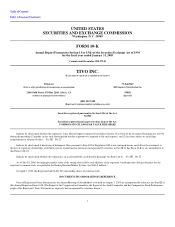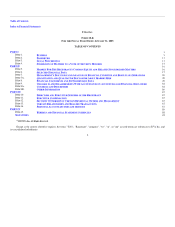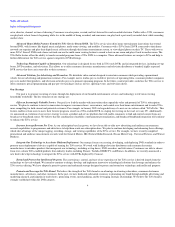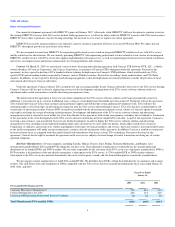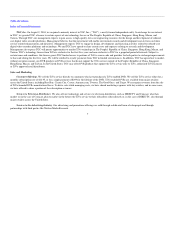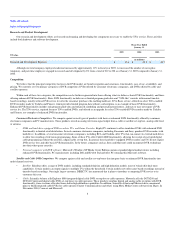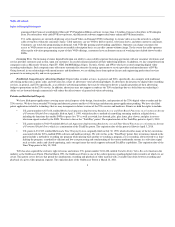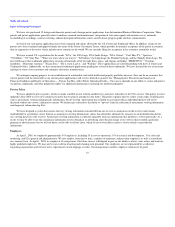TiVo 2004 Annual Report Download - page 10
Download and view the complete annual report
Please find page 10 of the 2004 TiVo annual report below. You can navigate through the pages in the report by either clicking on the pages listed below, or by using the keyword search tool below to find specific information within the annual report.
Table of Contents
Index to Financial Statements
announced that Comcast would deploy Microsoft TV Foundation Edition software to more than 1.0 million Comcast subscribers in Washington
State. For subscribers with cable DVR set-top boxes, this Microsoft software supports dual tuner enhanced DVR functionality.
U.S. cable operators are currently deploying server-based Video on Demand (VOD) technology to stream video across the network to a digital
cable set-top box within the consumer's home. Cable operators can use VOD to deliver movies, television shows, and other content to consumers.
Consumers can watch this programming on demand, with VCR-like pausing and rewinding capabilities. Operators can charge consumers for
access to VOD content on a per-transaction or monthly subscription basis, or can offer content without charge. To the extent that cable operators
offer regular television programming as part of their VOD offerings, consumers have an alternate means of watching time-shifted shows besides
DVRs.
Licensing Fees. Our licensing revenues depend both upon our ability to successfully negotiate licensing agreements with our consumer electronics and
service provider customers and, in turn, upon our customers' successful commercialization of their underlying products. In addition, we face competition from
companies such as Microsoft, Gemstar, OpenTV, NDS, D&M Holdings, Digeo, Ucentric, Gotuit, and 2Wire who have created competing digital video
recording technologies. Such companies may offer more economically attractive licensing agreements to service providers and manufacturers of DVRs.
Going forward, in our relationships with manufacturers and distributors, we are shifting focus from upfront license and engineering professional services
payments to recurring royalty and service payments.
Established Competition for Advertising Budgets. Digital video recorder services, in general, and TiVo, specifically, also compete with traditional
advertising media such as print, radio, and television for a share of advertisers' total advertising budgets. If advertisers do not perceive digital video recording
services, in general, and TiVo specifically, as an effective advertising medium, they may be reluctant to devote a significant portion of their advertising
budget to promotions on the TiVo service. In addition, advertisers may not support or embrace the TiVo technology due to a belief that our technology's
ability to fast-forward through commercials will reduce the effectiveness of general television advertising.
Patents and Intellectual Property
We have filed patent applications covering many critical aspects of the design, functionality, and operation of the TiVo digital video recorder and the
TiVo service. We have been awarded 70 foreign and domestic patents and have 106 foreign and domestic patent applications pending. We have also filed
patent applications related to technology that we may incorporate in future versions of the TiVo service and hardware. Patents we hold the rights to include:
• U.S. patent number 6,327,418, entitled Method and Apparatus Implementing Random Access and Time-Based Functions on a Continuous Stream
of Formatted Digital Data, originally filed on April 3, 1998, which describes a method of controlling streaming media in a digital device,
including the functions that enable DVRs to pause live TV as well as rewind, fast-forward, play, play faster, play slower, and play in reverse
television signals cached by the DVR. We refer to this as the "TrickPlay" patent. The expiration date of the TrickPlay patent is April 3, 2018.
• U.S. patent number 6,792,195 entitled Method and Apparatus Implementing Random Access and Time-Based Functions on a Continuous Stream
of Formatted Digital Data, which is a continuation of the TrickPlay patent. The expiration date of this patent is likewise April 3, 2018.
• U.S. patent 6,233,389, entitled Multimedia Time Warping System, originally filed on July 30, 1998, which describes many of the key inventions
associated with the TiVo-enabled DVR software and hardware design. We refer to this as the "TimeWarp" patent. Key inventions claimed in the
patent include a method for recording one program while playing back another or watching a program as it is recording, often referred to as time-
shifting the program; a method for efficient and low-cost processing and synchronizing of the various multimedia streams in a television signal
such as video, audio, and closed-captioning, and a storage format that easily supports advanced TrickPlay capabilities. The expiration date of the
Time Warp patent is July 30, 2018.
TiVo has also acquired the exclusive right to license and enforce U.S. patent number 5,241,428 entitled Variable-Delay Video Recorder known in the
industry as the Goldwasser Patent. Filed in March 1991, the Goldwasser Patent is one of the earliest patents regarding digital video recorders of which we are
aware. This patent covers devices that permit the simultaneous recording and playback of video material with a variable time delay between recording and
playback of a given video program segment. The expiration date of the Goldwasser Patent is March 12, 2011.
9


